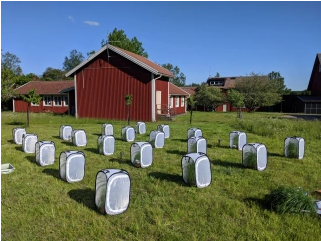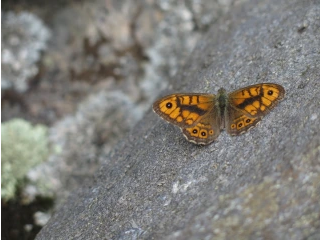Past projects
Diapause and climate change: constraints and evolutionary responses in Lepidoptera
Diapause, a period of seasonal inactivity, is a key part of life history for many insects; however, climate change complicates it in many ways. Anthropogenic climate change is altering the length of the growing season, the intensity of winter, the relationship between photoperiod and temperature, and species ranges, all of which have important implications for the production and function of diapause. I am working with a variety of Swedish butterfly species to investigate different ways that climate change interacts with the ecology and evolution of diapause. In collaboration with graduate student Mats Ittonen, we are conducting a reciprocal transplant of Lassiomata megera butterflies at three field sites across Sweden to determine how among-population variation in diapause cues influences phenology under natural conditions (see picture). This experiment also tests how the species performs north of its current range, which has expanded with recent climate change.
In another project, I am repeating experiments from the 1980s on the photoperiodic induction of diapause in Pararge aegeria butterflies to test if the associated reaction norm has evolved during the last >30 years as would be predicted due to the changing relationship between photoperiod and climate. I have also used Pieris napi to test the fitness consequences of spending a prolonged period in diapause under warm conditions, a scenario which should be more common as climate change extends the length of the growing season.

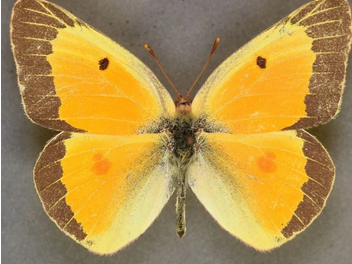
Evolution of seasonal plasticity in Colias eurytheme due to cue-environment mismatches caused by climate change
Many animals (and other organisms) use photoperiod as a cue for phenology and seasonal plasticity changes, since it provides a reliable way to determine the time of year and thus predict climatic conditions. Unfortunately, anthropogenic climate change has (and will continue to) alter this relationship between photoperiod and temperature, reducing the accuracy of photoperiod as a cue. I’m studying whether evolution has been able to compensate for this cue-environment mismatch in Colias eurytheme butterflies. This species uses photoperiod as a cue for a seasonal color change (see images), part of which has a known thermoregulatory function. By photographing and analyzing museum specimens collected over the last 60+ years, I can determine whether the time of year when the different morphs are produced has changed. Since photoperiod has remained constant, these changes would reflect an evolutionary change in the reaction norm. I’m also recreating lab experiments on these butterflies from the early 1970s to directly assess any changes in the reaction norm for the seasonal plasticity.
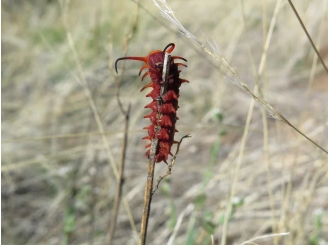
Interactions among plasticity in different traits and timescales in Battus philenor caterpillar thermoregulation
Living things can often respond to environmental change with plasticity in multiple traits, but how do these different responses interact? A good example of this occurs in Battus philenor butterflies, which can avoid high temperatures both behaviorally (by seeking thermal refuges off their host plants) and via developmental color change (switching from black to red when they molt at high temperatures).
In my research, I’ve used field and lab experiments to investigate the interactions between these two changes. I’ve shown that red caterpillars seek refuges less because of their cooler body temperatures; however, once they do seek a refuge, color actually has minimal effect on body temperature or survival. Thus, in this case, the two changes complement each other, with behavior being an effective, rapid response to short term changes, while color plasticity is a more efficient response to long term changes. I’ve also investigated local adaptation of these forms of plasticity across the species range in the US, finding that both are maintained with nearly identical reaction norms, despite the fact that only black caterpillars are observed in the wild for much of the species range.
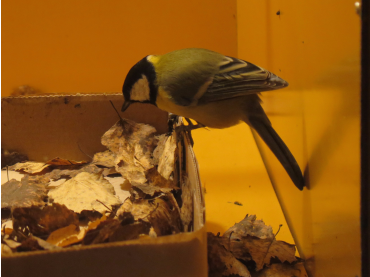
Potential tradeoffs between thermoregulation and avian predator avoidance in Arctia plantaginis caterpillars
In addition to having to balance variation in multiple traits, animals also need to balance multiple functions. To better understand how multiple traits interact with multiple functions, I’ve worked with Johanna Mappes in Jyväskylä, Finland to study how behavior and color pattern affect both temperature and predation risk in Arctia plantaginis caterpillars. These caterpillars are mildly aposematic; they are edible, but disliked by birds, including Parus major, which we used as a model predator. We designed experiments testing how variation in color pattern (the size of the warning signal) and position affected temperature of the caterpillars in the field and also risk of attack in lab experiments. We also performed experiments similar to those I developed for Battus philenor, testing whether signal-size variation altered the caterpillars thermoregulatory behavior.

